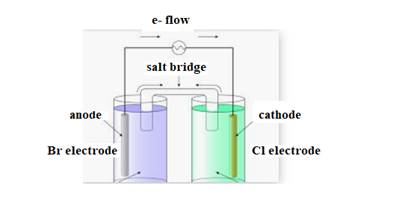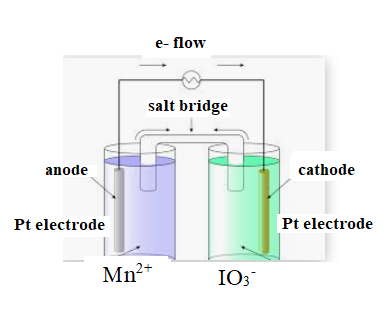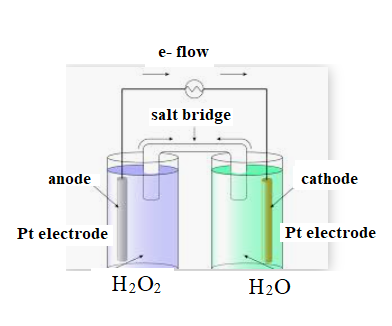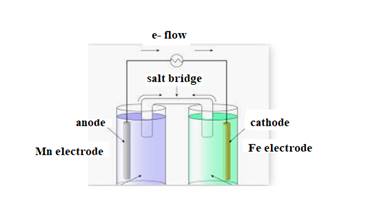
(a)
Interpretation:
The sketch of galvanic cell along with cathode and anode and the direction of electron flow, the direction of flow of ions through salt bridge, the balanced chemical equation and the E0cell should be predicted.
Concept Introduction:
In galvanic cell chemical energy converted into electrical energy.
At anode oxidation takes place which means loss of electrons.
At cathode reduction takes place which means gain of electrons.
(a)
Answer to Problem 21E
The E0cell is0.27 V
Reaction at anode:
Reaction at cathode:
Overall reaction:
Explanation of Solution
Given information:
The diagram of cell is shown below:

The direction of flow of electrons is from anode to cathode.
Negative ions flow towards anode.
At anode oxidation takes place
At cathode reduction takes place.
The cell representation is shown below:
The oxidation half-cell reaction is shown below:
The reduction half-cell reaction is shown below:
The overall reaction is shown below:
The calculation of E0cell is shown below:
E0cell = E0cathode − E0anode
= 1.36 − (-1.09)
= 0.27 V
(b)
Interpretation:
The sketch of galvanic cell along with cathode and anode and the direction of electron flow, the direction of flow of ions through salt bridge, the balanced chemical equation and the E0cell should be predicted.
Concept Introduction:
In galvanic cell chemical energy converted into electrical energy.
At anode oxidation takes place which means loss of electrons.
At cathode reduction takes place which means gain of electrons.
(b)
Answer to Problem 21E
The E0cell is 0.09 V
Reaction at anode:
Reaction at cathode:
Overall reaction:
Explanation of Solution
Given information:
The diagram is shown below:

The direction of flow of electrons is from anode to cathode.
Negative ions flow towards anode.
At anode oxidation takes place
At cathode reduction takes place.
The oxidation half-cell reaction is shown below:
The reduction half-cell reaction is shown below:
The overall reaction is shown below:
The calculation of E0cell is shown below:
E0cell = E0cathode − E0anode
= 1.60 − 1.51
= 0.09 V
(c)
Interpretation:
The sketch of galvanic cell along with cathode and anode and the direction of electron flow, the direction of flow of ions through salt bridge, the balanced chemical equation and the E0cell should be predicted.
Concept Introduction:
In galvanic cell chemical energy converted into electrical energy.
At anode oxidation takes place which means loss of electrons.
At cathode reduction takes place which means gain of electrons.
(c)
Answer to Problem 21E
The E0cell is 1.10 V
Reaction at anode:
Reaction at cathode:
Overall reaction:
Explanation of Solution
Given information:
The diagram is shown below:

The direction of flow of electrons is from anode to cathode.
Negative ions flow towards anode.
At anode oxidation takes place
At cathode reduction takes place.
The oxidation half-cell reaction is shown below:
The reduction half-cell reaction is shown below:
The overall reaction is shown below:
The calculation of E0cell is shown below:
E0cell = E0cathode − E0anode
= 1.78 − 0.68
= 1.10 V
(d)
Interpretation:
The sketch of galvanic cell along with cathode and anode and the direction of electron flow, the direction of flow of ions through salt bridge, the balanced chemical equation and the E0cell should be predicted.
Concept Introduction:
In galvanic cell chemical energy converted into electrical energy.
At anode oxidation takes place which means loss of electrons.
At cathode reduction takes place which means gain of electrons.
(d)
Answer to Problem 21E
The E0cell is 1.14 V
Reaction at anode:
Reaction at cathode:
Overall reaction:
Explanation of Solution
Given information:
The diagram is shown below:

The direction of flow of electrons is from anode to cathode.
Negative ions flow towards anode.
At anode oxidation takes place
At cathode reduction takes place.
The oxidation half-cell reaction is shown below:
The reduction half-cell reaction is shown below:
The overall reaction is shown below:
The calculation of E0cell is shown below:
E0cell = E0cathode − E0anode
= - 0.036- (-1.18)
= 1.14 V
Want to see more full solutions like this?
Chapter 11 Solutions
EBK CHEMICAL PRINCIPLES
- How many particles does a face-centered cubic (fcc) unit cell contain? Group of answer choices 2 14 8 4arrow_forwardV Highlight all of the carbon atoms that have at least one beta (B) hydrogen, using red for one ẞ hydrogen, blue for two ẞ hydrogens, and green for three ẞ hydrogens. If none of the carbon atoms have ẞ hydrogens, check the box underneath the molecule. ED X None of the carbon atoms have ẞ hydrogens. Explanation esc 2 Check * F1 F2 1 2 80 # 3 Q W tab A caps lock shift fn control F3 N S option O 694 $ F4 F5 F6 005 % E R D F LL 6 olo 18 Ar B © 2025 McGraw Hill LLC. All Rights Reserved. Terms of Use | Privacy Center | Accessibility A DII F7 F8 87 & * 8 T Y U G H 4 F9 F10 ( 9 0 E F11 F12 உ J K L + || X C V B N M H H command option commandarrow_forwardConsider the reaction below and answer the following questions. Part 1 of 4 Br NaOCH2CH3 Identify the mechanisms involved. Check all that apply. SN 1 SN 2 E1 E2 None of the above Part 2 of 4 Skip Part Check esc F1 F2 lock 1 2 Q W A S #3 80 F3 F4 F5 F6 Save For © 2025 McGraw Hill LLC. All Rights Reserved. Terms ˇˇ % & 4 5 6 89 7 IK A 分 བ F7 F8 F9 F * E R T Y U 8 9 D F G H K V B N M 0 Oarrow_forward
- What kind of holes are not generated when solid-state particles adopt a close packing pattern? Group of answer choices tetrahedral cubic octahedral None of the other choices are correctarrow_forwardFor the reaction below: 1. Draw all reasonable elimination products to the right of the arrow. 2. In the box below the reaction, redraw any product you expect to be a major product. 田 Major Product: Check ☐ + I Na OH esc F1 F2 2 1 @ 2 Q W tab A caps lock S #3 80 F3 69 4 σ F4 % 95 S Click and drag to sta drawing a structure mm Save For Later 2025 McGraw Hill LLC. All Rights Reserved. Terms of Use GO DII F5 F6 F7 F8 F9 F10 6 CO 89 & 7 LU E R T Y U 8* 9 0 D F G H J K L Z X C V B N M 36arrow_forwardProblem 7 of 10 Draw the major product of this reaction. Ignore inorganic byproducts. S' S 1. BuLi 2. ethylene oxide (C2H4O) Select to Draw a Submitarrow_forward
- Feedback (4/10) 30% Retry Curved arrows are used to illustrate the flow of electrons. Use the reaction conditions provided and follow the arrows to draw the reactant and missing intermediates involved in this reaction. Include all lone pairs and charges as appropriate. Ignore inorganic byproducts. Incorrect, 6 attempts remaining :0: Draw the Reactant H H3CO H- HIO: Ö-CH3 CH3OH2* protonation H. a H (+) H Ο CH3OH2 O: H3C protonation CH3OH deprotonation > CH3OH nucleophilic addition H. HO 0:0 Draw Intermediate a Xarrow_forwardCan I please get the blank spaces answered/answers?arrow_forward1. Identify the following alkenes as E or Z NH₂ Br 2. Draw the structures based on the IUPAC names (3R,4R)-3-bromo-4-fluoro- 1-hexene (Z)-4-bromo-2-iodo-3-ethyl- 3-heptene تر 3. For the following, predict all possible elimination product(s) and circle the major product. HO H₂SO4 Heat 80 F4 OH H2SO4 Heat 어요 F5 F6 1 A DII 4 F7 F8 F9 % & 5 6 7 * ∞ 8 BAB 3 E R T Y U 9 F D G H J K O A F11 F10arrow_forward
- Draw the major product of this reaction. Ignore inorganic byproducts. ○ O 1. H₂O, pyridine 2. neutralizing work-up a N W X 人 Parrow_forward✓ Check the box under each molecule that has a total of five ẞ hydrogens. If none of the molecules fit this description, check the box underneath the table. tab OH CI 0 Br xx Br None of these molecules have a total of five ẞ hydrogens. esc Explanation Check caps lock shift 1 fn control 02 F2 W Q A N #3 S 80 F3 E $ t 01 205 % 5 F5 & 7 © 2025 McGraw Hill LLC. All Rights Reserved. Terms of Use | Privacy Center | Accessibility FT * 8 R T Y U כ F6 9 FIG F11 F D G H J K L C X V B < N M H option command P H + F12 commandarrow_forwardDraw the major product of this reaction. Ignore inorganic byproducts and the carboxylic acid side product. O 1. CHзMgBr (excess) 2. H₂O ✓ W X 人arrow_forward
 ChemistryChemistryISBN:9781305957404Author:Steven S. Zumdahl, Susan A. Zumdahl, Donald J. DeCostePublisher:Cengage Learning
ChemistryChemistryISBN:9781305957404Author:Steven S. Zumdahl, Susan A. Zumdahl, Donald J. DeCostePublisher:Cengage Learning Chemistry: An Atoms First ApproachChemistryISBN:9781305079243Author:Steven S. Zumdahl, Susan A. ZumdahlPublisher:Cengage Learning
Chemistry: An Atoms First ApproachChemistryISBN:9781305079243Author:Steven S. Zumdahl, Susan A. ZumdahlPublisher:Cengage Learning
 Principles of Modern ChemistryChemistryISBN:9781305079113Author:David W. Oxtoby, H. Pat Gillis, Laurie J. ButlerPublisher:Cengage Learning
Principles of Modern ChemistryChemistryISBN:9781305079113Author:David W. Oxtoby, H. Pat Gillis, Laurie J. ButlerPublisher:Cengage Learning General Chemistry - Standalone book (MindTap Cour...ChemistryISBN:9781305580343Author:Steven D. Gammon, Ebbing, Darrell Ebbing, Steven D., Darrell; Gammon, Darrell Ebbing; Steven D. Gammon, Darrell D.; Gammon, Ebbing; Steven D. Gammon; DarrellPublisher:Cengage Learning
General Chemistry - Standalone book (MindTap Cour...ChemistryISBN:9781305580343Author:Steven D. Gammon, Ebbing, Darrell Ebbing, Steven D., Darrell; Gammon, Darrell Ebbing; Steven D. Gammon, Darrell D.; Gammon, Ebbing; Steven D. Gammon; DarrellPublisher:Cengage Learning Chemistry: Principles and ReactionsChemistryISBN:9781305079373Author:William L. Masterton, Cecile N. HurleyPublisher:Cengage Learning
Chemistry: Principles and ReactionsChemistryISBN:9781305079373Author:William L. Masterton, Cecile N. HurleyPublisher:Cengage Learning





